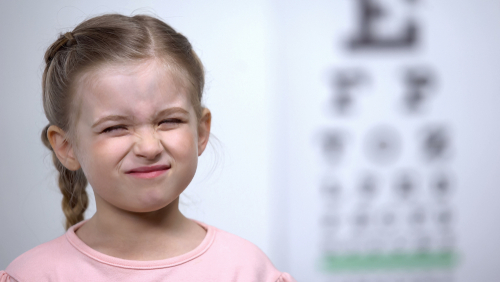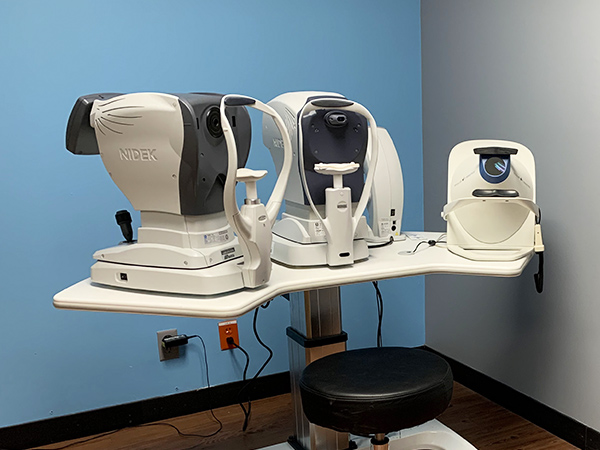
The problem with the eye chart
Your child could see 20/20 at their annual eye exam, but still struggle to read in school. Why does this happen? Because reading the eye chart at the doctor’s office takes only a few seconds and requires tiny eye movements. But reading a book for hours? That takes a different set of visual skills.
The eye chart tests visual acuity, how well your child can see. Most eye exams don’t test more than that. Reading a book requires accurate eye tracking, teamwork, and focusing, plus many more visual skills.
One in four children has a vision-related learning problem, and most don’t know it.
Try this for yourself.
Look at a sign across the room and read it out loud.
Read a paragraph in a book silently.
Have someone watch your eyes both times.
Usually, people notice that their eyes move very little when they read something far away. When they read something up close, their eyes move quite a bit, tracking across the page and then jumping back to start a new line.
If your child’s eyes don’t work together perfectly, reading will be difficult, frustrating, and slow, even if their vision is “perfect” when they read the eye chart.
Warning signs of an undiagnosed vision problem
Headaches
Eyes feel tired or strained
Words move on the page
Words look double
Poor reading comprehension but excellent auditory comprehension
Short attention span when reading
Poor handwriting
Poor depth perception
Does not recognize familiar words
Takes a long time to complete assignments
Skips words or lines when reading
Misaligns columns of numbers
Difficulty copying from the board
Closes an eye or tilts the head when reading
Avoids schoolwork
Reversing letters and numbers
Children with these types of vision problems may be labelled as lazy, unmotivated, or attention seekers. They will do anything to get out of doing schoolwork. When you understand that they are struggling with their vision, it makes sense that they act out.
Eye charts don’t tell the full story. A developmental or functional vision exam can uncover problems that standard tests miss.
Children at risk
In 2018, researchers at Harvard Medical School conducted a study to compare the visual skills of children with developmental dyslexia and non-dyslexic children. In the dyslexic group, 79% of children had at least one visual skill deficit compared to 33% of their peers.1
And it’s not just dyslexia.2,3 Children diagnosed with ADHD, autism, and other learning challenges are also far more likely to have underlying vision-related problems.4,5,6 Yet most of these children never receive a vision exam that goes beyond the basic eye chart.
Take action now to help your child succeed
If your child struggles in school, especially if they have been diagnosed with ADHD, dyslexia, or autism, they should be evaluated by an optometrist trained in functional or developmental vision. These aren’t just “nice to have” skills. They are essential for learning.
Dr. Bontrager is residency-trained in the diagnosis and treatment of visual skills needed for reading and learning. She routinely tests these skills in children and adults. Give us a call today to schedule a full vision evaluation, not just a screening.
References
Raghuram, A., Gowrisankaran, S., Swanson, E., Zurakowski, D., Hunter, D. G., & Waber, D. P. (2018). Frequency of Visual Deficits in Children With Developmental Dyslexia. JAMA ophthalmology, 136(10), 1089–1095. https://doi.org/10.1001/jamaophthalmol.2018.2797
Kristjánsson, Á., & Sigurdardottir, H. M. (2023). The Role of Visual Factors in Dyslexia. Journal of cognition, 6(1), 31. https://doi.org/10.5334/joc.287
Ward, L. M., & Kapoula, Z. (2020). Differential diagnosis of vergence and saccade disorders in dyslexia. Scientific reports, 10(1), 22116. https://doi.org/10.1038/s41598-020-79089-1
Autism Research Institute (2017, June 30). Eye movements offer clues about symptoms in autism. Autism Research Center International. Retrieved July 9, 2025, from https://arrionline.org/eye-movements-offer-clues-about-symptoms-in-autism/
Reimelt, C., Wolff, N., Hölling, H., Mogwitz, S., Ehrlich, S., & Roessner, V. (2021). The Underestimated Role of Refractive Error (Hyperopia, Myopia, and Astigmatism) and Strabismus in Children With ADHD. Journal of attention disorders, 25(2), 235–244. https://doi.org/10.1177/1087054718808599
Ababneh, L. T., Bashtawi, M., Ababneh, B. F., Mahmoud, I. H., Rashdan, M., & Zahran, M. (2020). Ocular findings in children with attention deficit hyperactivity disorder: A Case-Control study. Annals of medicine and surgery (2012), 57, 303–306. https://doi.org/10.1016/j.amsu.2020.08.005











